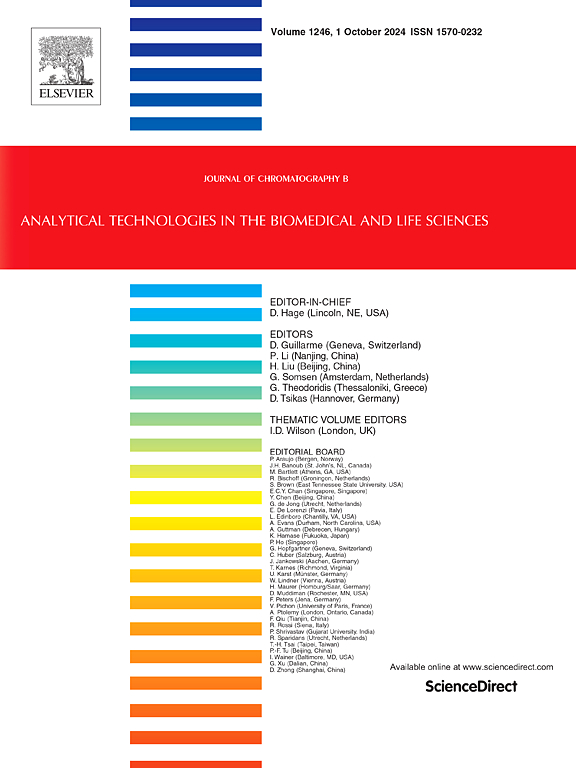Heteroatom cobalt-based metal-organic framework and reduced graphene oxide nanocomposite for dispersive solid phase extraction of caffeine from exhaled breath condensate samples of premature infants prior to HPLC-PDA
IF 2.8
3区 医学
Q2 BIOCHEMICAL RESEARCH METHODS
引用次数: 0
Abstract
A cobalt-based metal–organic framework and graphene oxide were combined to prepare a new nanocomposite for extracting of caffeine from exhaled breath condensate (EBC) samples. Dispersive micro solid phase extraction of caffeine was conducted using the nanocomposite as a sorbent by adding 10 mg of it to the sample solution and vortexing for 3 min. After extracting of the analyte, it was eluted using the mobile phase. The analyte was then analyzed using high performance liquid chromatography-photodiode array detector. Under optimal conditions, the limit of detection, limit of quantification, and linear range of the calibration curve were found to be 1.7, 5.9, and 10–500 µg/L, respectively. To assess the precision of the method, five replicates of standard solutions containing caffeine at two different concentration levels (50 and 100 µg/L) were tested. The relative standard deviations for intra- and inter-day precisions ranged from 4.3 to 6.8 %. The applicability of the method was demonstrated by analyzing the samples obtained from premature infants undergoing caffeine treatment and caffeine concentrations were 4.9 ± 0.6, 2.7 ± 0.2 µg/L in the EBC samples of who were under treatment by a 5-mg dose. Also, caffeine concentrations were 5.9 ± 0.3 and 18 ± 0.6 µg/L in the the infants who obtained the 10-mg and 25-mg doses, respectively. The results indicated a satisfactory, extraction recovery of 86 % showcasing the method’s reliability and effectiveness in analyzing real samples.
异构体钴基金属有机框架和还原氧化石墨烯纳米复合材料用于在 HPLC-PDA 前从早产儿呼出气体冷凝物样品中分散固相萃取咖啡因
研究人员将钴基金属有机框架和氧化石墨烯结合起来,制备了一种新型纳米复合材料,用于从呼气冷凝液(EBC)样品中提取咖啡因。在样品溶液中加入 10 毫克纳米复合材料并涡旋 3 分钟,以纳米复合材料为吸附剂进行咖啡因的分散微固相萃取。提取分析物后,使用流动相进行洗脱。然后使用高效液相色谱-光电二极管阵列检测器对分析物进行分析。在最佳条件下,校准曲线的检出限、定量限和线性范围分别为 1.7、5.9 和 10-500 µg/L。为了评估该方法的精密度,对含有咖啡因的两种不同浓度水平(50 微克/升和 100 微克/升)的标准溶液进行了五次重复检测。日内和日间精密度的相对标准偏差为 4.3% 至 6.8%。通过分析接受咖啡因治疗的早产儿样本,证明了该方法的适用性,在接受 5 毫克剂量治疗的早产儿 EBC 样本中,咖啡因浓度分别为 4.9 ± 0.6 µg/L、2.7 ± 0.2 µg/L。此外,服用 10 毫克和 25 毫克剂量的婴儿体内咖啡因浓度分别为 5.9 ± 0.3 微克/升和 18 ± 0.6 微克/升。结果表明,该方法的提取回收率为 86%,令人满意,显示了该方法在分析实际样品时的可靠性和有效性。
本文章由计算机程序翻译,如有差异,请以英文原文为准。
求助全文
约1分钟内获得全文
求助全文
来源期刊

Journal of Chromatography B
医学-分析化学
CiteScore
5.60
自引率
3.30%
发文量
306
审稿时长
44 days
期刊介绍:
The Journal of Chromatography B publishes papers on developments in separation science relevant to biology and biomedical research including both fundamental advances and applications. Analytical techniques which may be considered include the various facets of chromatography, electrophoresis and related methods, affinity and immunoaffinity-based methodologies, hyphenated and other multi-dimensional techniques, and microanalytical approaches. The journal also considers articles reporting developments in sample preparation, detection techniques including mass spectrometry, and data handling and analysis.
Developments related to preparative separations for the isolation and purification of components of biological systems may be published, including chromatographic and electrophoretic methods, affinity separations, field flow fractionation and other preparative approaches.
Applications to the analysis of biological systems and samples will be considered when the analytical science contains a significant element of novelty, e.g. a new approach to the separation of a compound, novel combination of analytical techniques, or significantly improved analytical performance.
 求助内容:
求助内容: 应助结果提醒方式:
应助结果提醒方式:


